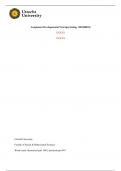Assignment Developmental Neuropsychology (201800818)
XXXXX
XXXXX
Utrecht University
Faculty of Social & Behavioural Sciences
Word count: theoretical part 1443; practical part 991
, Theoretical part
Attentional functions are crucial for the establishment of new knowledge and the acquisition
of new skills. These functions are mediated by a diffuse functional neural network and are
vulnerable to impairments in brain development (Anderson et al., 2019). Impairments can
occur due to genetic and environmental risks and could significantly impact cognitive
outcomes. Therefore, early identification of deviations from normal development is important
for enabling intervention strategies. In order to gain a thorough attentional profile of an
individual child and screen for deviations, each of the following components should be
evaluated: directed attention, selective attention, divided attention, sustained attention or
vigilance, and attentional control (Anderson et al., 2019). Reliable and validated age-
appropriate instruments are needed to differentiate normal and abnormal development. This
paper aimed to provide an overview of various neurocognitive tasks designed to measure
different attentional components in children (i.e., selective attention, sustained attention or
vigilance, and attentional control). Moreover, this paper aimed to report the underlying
neurocognitive functions of each task and how these develop over time.
Apple task
In the apple task, the child is given a sheet of paper with 180 items on it, of which are
81 strawberries, 81 green apples, and 18 red apples. The child has to find and point out as
many red apples as possible within the allotted time of 60 seconds. The maximum score is 18,
and is achieved when all red apples are pointed out. The Apple task measures selective
attention as it demands a child to focus on a target stimulus and generate a motor response
with the irrelevant or distractor stimuli that are presented (e.g., strawberries and green apples)
(Stevens & Bavelier, 2012). As the target items have no distinct features to attract attention,
top-down attentional processing occurs (Baluch & Itti, 2011). Different brain regions are
involved in this selective attention and top-down process: the superior frontal cortex, inferior
parietal cortex, superior temporal, and insula (Hopfinger et al., 2000; Paneri & Gregoriou,
2017). Children start to develop the ability for selective attention during their first year of life
(Lewkowicz et al., 2012; Anderson et al., 2001). This development shows growth spurts
between the ages 3 to 6, 8 to 10, and a final spurt around age 15 (Anderson et al., 2001).
The Apple task is an example of a conjunction search task, in which one is required to
find a target among several distractors, and the target is dined by a unique conjunction of
features. In this type of search task, locating the target is more difficult because distractors






